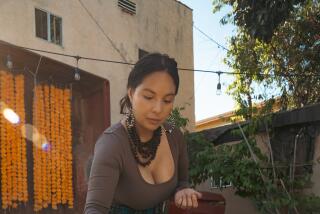Sweet and spicy: Chocolate persimmon and GoldRush apples
The so-called Tsurunoko or Chocolate persimmon is a most mysterious, elusive and alluring fruit. Technically speaking, it belongs to the obscure class of “pollination-variant, nonastringent” persimmons, in which small quantities of alcohol exuded from the seeds cause the tannins in the flesh to clump together, turning the pulp brown, softening the astringency and developing a rich, distinctive flavor.
In addition to being very sweet, as any decent persimmon should be when ripe, a Chocolate persimmon offers a spicy complexity that is most appealing. However, if the flower from which the fruit arose was not pollinated, no seeds occur, meaning the flesh remains yellow-orange and stays mouth-puckeringly astringent until it turns soft, like the familiar Hachiya. Even stranger, fruits that have been only partially pollinated can be brown and sweet on one side, pale and puckery on the other.
Such inconstancy is the kiss of death for commercial producers, but Japanese immigrants have long prized this variety and grown it in their backyards; they also established a few small-scale plantings, mostly in Placer County, in the Sierra foothills, from which the fruit is sold to local, ethnic and farmers markets. Jeff Rieger of Penryn Orchard Specialties, who bought his farm from a retired Japanese American, and sells at the Santa Monica Wednesday market, is one of the very few sources for this legendary fruit in Southern California.
Chocolates can be eaten hard like Fuyu types but are at their best when slightly soft, buttery and juicy, not gelatinous like a Hachiya. Since Rieger started selling them several years ago, they have acquired a devoted following among chefs like D.J. Olsen of Lou Wine Bar, who prepares a version of sticky toffee pudding with Chocolate persimmons instead of dates.
Despite this variety’s deliciousness, its name is problematic. According to most scientific literature old and new, the variety popularly called Tsurunoko in California is not the real Tsurunoko: Although both have a similar elongated acorn shape, the true Tsurunoko is actually an astringent variety that never turns brown, like Hachiya. The “Chocolate” moniker is just a recent marketing invention, like “mango nectarine” or “yumberry,” but it may be the best available until scientists run a molecular marker study comparing data from local persimmon varieties and reliably identified cultivars in Japan to determine the Chocolate’s original name and sort out the confused nomenclature that bedevils so many persimmon varieties here.
GoldRush apples
Many apple connoisseurs who believed that no modern variety can match the best older ones in intensity and complexity have changed their minds in recent years upon discovering GoldRush. As grown by Mike Cirone in See Canyon, San Luis Obispo, it is very high in both sweetness and acidity, rich and spicy, with a strong Golden Delicious aroma, explosively crunchy and long storing -- about as good as an apple can be.
Ironically, the breeders of GoldRush, a team of university researchers including the eminent pomologist Jules Janick of Purdue, were attempting to select for resistance to apple scab, a common fungal disease, rather than superior flavor. Over six generations of hybrids starting in 1945 they crossed a Siberian crab apple of a species called Malus floribunda with Rome Beauty, Golden Delicious, Melrose, a Winesap seedling and Golden Delicious again, to produce the original GoldRush seedling, which was planted in Indiana in 1973. The variety almost didn’t make it, because the two trees in the second test planting were girdled when mice nibbled their bark all the way around, but they were saved by rootstock grafted above the wound. After many years of tests, the variety was released in 1993 and named GoldRush to emphasize its deep golden color and rush of flavor.
GoldRush is so high in acidity that in the Northeast it requires several weeks of storage to mellow, but California, with its long growing season, can ripen it so that it tastes great right off the tree. For Cirone, it is one of his latest apple varieties, and one of his favorites, bringing to mind the old French saying, “bon fruit murit tard,” meaning “good fruit ripens late.” Its light skin does tend to sunburn, but that doesn’t really harm the eating quality, and often the slightly sunburned specimens, having enjoyed a favored position on the tree, are particularly flavorful.
Because of its intense flavor at harvest, modest size and minor cosmetic flaws, GoldRush has not been a commercial success, but it has become a cult favorite at the Santa Monica Wednesday market, where a scrum often ensues as soon as Cirone or his workers set out the boxes. His 200 trees have a good crop of GoldRush this season, he says, and he will bring them to market the next two weeks (Oct. 21 and 28).
More to Read
Eat your way across L.A.
Get our weekly Tasting Notes newsletter for reviews, news and more.
You may occasionally receive promotional content from the Los Angeles Times.






